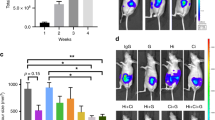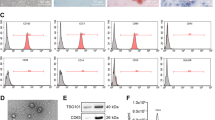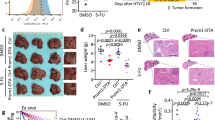Abstract
The poor outcome of cancer gene therapy in clinical trials relates in part to insufficient gene delivery to tumor sites. Mesenchymal stem cells (MSCs) represent a new tool for the delivery of therapeutic agents to tumor cells. This study used an orthotopic nude mice model of hepatocellular carcinoma (HCC) to evaluate the potential of genetically modified human MSCs (hMSCs), to function as an effective delivery vehicle for therapeutic genes. hMSCs derived from the bone marrow were efficiently engineered to express human pigment epithelium-derived factor (PEDF) by lentiviral transduction, then tested in vitro for high-level expression and bioactivity of the transgenic protein. The preferential homing of hMSCs toward HCC was confirmed by in vitro and in vivo migration assays. in vivo efficacy experiments showed that intravenous (i.v.) injection of PEDF-expressing hMSCs significantly suppressed both the growth of primary liver tumors and the development of pulmonary metastases. Moreover, hMSCs-based PEDF gene delivery moderately increased the systemic levels of human PEDF. Immunohistochemistry of primary liver tumors demonstrated lower microvessel density in mice treated with hMSCs-PEDF than in control mice. This is the first study to show the potential of hMSCs as an effective delivery vehicle for therapeutic genes in the treatment of HCC.
This is a preview of subscription content, access via your institution
Access options
Subscribe to this journal
Receive 50 print issues and online access
$259.00 per year
only $5.18 per issue
Buy this article
- Purchase on Springer Link
- Instant access to full article PDF
Prices may be subject to local taxes which are calculated during checkout







Similar content being viewed by others
Abbreviations
- CM:
-
conditioned media
- ELISA:
-
enzyme-linked immunosorbent assay
- GFP:
-
green fluorescence protein
- HCC:
-
hepatocellular carcinoma
- hMSC:
-
human mesenchymal stem cell
- IRES:
-
internal ribosomal entry site
- i.v.:
-
intravenous
- MSC:
-
mesenchymal stem cell
- PBS:
-
phosphate-buffered saline
- PEDF:
-
pigment epithelium-derived factor
References
Bernardo ME, Zaffaroni N, Novara F, Cometa AM, Avanzini MA, Moretta A et al. (2007). Human bone marrow derived mesenchymal stem cells do not undergo transformation after long-term in vitro culture and do not exhibit telomere maintenance mechanisms. Cancer Res 67: 9142–9149.
Cai J, Parr C, Watkins G, Jiang WG, Boulton M . (2006). Decreased pigment epithelium-derived factor expression in human breast cancer progression. Clin Cancer Res 12: 3510–3517.
Chang CJ, Chen YH, Huang KW, Cheng HW, Chan SF, Tai KF et al. (2007). Combined GM-CSF and IL-12 gene therapy synergistically suppresses the growth of orthotopic liver tumors. Hepatology 45: 746–754.
Chen QR, Zhang L, Gasper W, Mixson AJ . (2001). Targeting tumor angiogenesis with gene therapy. Mol Genet Metab 74: 120–127.
Dawson DW, Volpert OV, Gillis P, Crawford SE, Xu H, Benedict W et al. (1999). Pigment epithelium-derived factor: a potent inhibitor of angiogenesis. Science 285: 245–248.
Dwyer RM, Potter-Beirne SM, Harrington KA, Lowery AJ, Hennessy E, Murphy JM et al. (2007). Monocyte chemotactic protein-1 secreted by primary breast tumors stimulates migration of mesenchymal stem cells. Clin Cancer Res 13: 5020–5027.
Ek ET, Dass CR, Contreras KG, Choong PF . (2007). Pigment epithelium-derived factor overexpression inhibits orthotopic osteosarcoma growth, angiogenesis and metastasis. Cancer Gene Ther 14: 616–626.
Filleur S, Volz K, Nelius T, Mirochnik Y, Huang H, Zaichuk TA et al. (2005). Two functional epitopes of pigment epithelial-derived factor block angiogenesis and induce differentiation in prostate cancer. Cancer Res 65: 5144–5152.
Fritz V, Jorgensen C . (2008). Mesenchymal stem cells: an emerging tool for cancer targeting and therapy. Curr Stem Cell Res Ther 3: 32–42.
Gao Y, Zhang W, Zhao L, Wang XH . (2009). [Pigment epithelium-derived factor gene therapy inhibits the growth of transplanted human hepatocellular carcinoma in nude mice]. Zhonghua Gan Zang Bing Za Zhi 17: 363–367.
Garcia M, Fernandez-Garcia NI, Rivas V, Carretero M, Escamez MJ, Gonzalez-Martin A et al. (2004). Inhibition of xenografted human melanoma growth and prevention of metastasis development by dual antiangiogenic/antitumor activities of pigment epithelium-derived factor. Cancer Res 64: 5632–5642.
Guan M, Yam HF, Su B, Chan KP, Pang CP, Liu WW et al. (2003). Loss of pigment epithelium derived factor expression in glioma progression. J Clin Pathol 56: 277–282.
Halin S, Wikstrom P, Rudolfsson SH, Stattin P, Doll JA, Crawford SE et al. (2004). Decreased pigment epithelium-derived factor is associated with metastatic phenotype in human and rat prostate tumors. Cancer Res 64: 5664–5671.
Haralabopoulos GC, Grant DS, Kleinman HK, Lelkes PI, Papaioannou SP, Maragoudakis ME . (1994). Inhibitors of basement membrane collagen synthesis prevent endothelial cell alignment in Matrigel in vitro and angiogenesis in vivo. Lab Invest 71: 575–582.
Hung SC, Deng WP, Yang WK, Liu RS, Lee CC, Su TC et al. (2005). Mesenchymal stem cell targeting of microscopic tumors and tumor stroma development monitored by noninvasive in vivo positron emission tomography imaging. Clin Cancer Res 11: 7749–7756.
Kanehira M, Xin H, Hoshino K, Maemondo M, Mizuguchi H, Hayakawa T et al. (2007). Targeted delivery of NK4 to multiple lung tumors by bone marrow-derived mesenchymal stem cells. Cancer Gene Ther 14: 894–903.
Khakoo AY, Pati S, Anderson SA, Reid W, Elshal MF, Rovira et al. (2006). Human mesenchymal stem cells exert potent antitumorigenic effects in a model of Kaposi's sarcoma. J Exp Med 203: 1235–1247.
Kidd S, Spaeth E, Dembinski JL, Dietrich M, Watson K, Klopp A et al. (2009). Direct evidence of mesenchymal stem cell tropism for tumor and wounding microenvironments using in vivo bioluminescence imaging. Stem Cells 27: 2614–2623.
Kikuchi E, Menendez S, Ohori M, Cordon-Cardo C, Kasahara N, Bochner BH . (2004). Inhibition of orthotopic human bladder tumor growth by lentiviral gene transfer of endostatin. Clin Cancer Res 10: 1835–1842.
Komarova S, Kawakami Y, Stoff-Khalili MA, Curiel DT, Pereboeva L . (2006). Mesenchymal progenitor cells as cellular vehicles for delivery of oncolytic adenoviruses. Mol Cancer Ther 5: 755–766.
Lau WY, Lai EC . (2008). Hepatocellular carcinoma: current management and recent advances. Hepatobiliary Pancreat Dis Int 7: 237–257.
Lee TK, Man K, Ho JW, Wang XH, Poon RT, Xu Y et al. (2005). FTY720: a promising agent for treatment of metastatic hepatocellular carcinoma. Clin Cancer Res 11: 8458–8466.
Matsumoto K, Ishikawa H, Nishimura D, Hamasaki K, Nakao K, Eguchi K . (2004). Antiangiogenic property of pigment epithelium-derived factor in hepatocellular carcinoma. Hepatology 40: 252–259.
Mittler J, Pascher A, Neuhaus P, Pratschke J . (2008). The utility of extended criteria donor organs in severely ill liver transplant recipients. Transplantation 86: 895–896.
Mizuguchi H, Sasaki T, Kawabata K, Sakurai F, Hayakawa T . (2005). Fiber-modified adenovirus vectors mediate efficient gene transfer into undifferentiated and adipogenic-differentiated human mesenchymal stem cells. Biochem Biophys Res Commun 332: 1101–1106.
Nakamizo A, Marini F, Amano T, Khan A, Studeny M, Gumin J et al. (2005). Human bone marrow-derived mesenchymal stem cells in the treatment of gliomas. Cancer Res 65: 3307–3318.
Ou-Yang F, Lan KL, Chen CT, Liu JC, Weng CL, Chou CK et al. (2006). Endostatin-cytosine deaminase fusion protein suppresses tumor growth by targeting neovascular endothelial cells. Cancer Res 66: 378–384.
Persano L, Crescenzi M, Indraccolo S . (2007). Anti-angiogenic gene therapy of cancer: current status and future prospects. Mol Aspects Med 28: 87–114.
Pittenger MF, Mackay AM, Beck SC, Jaiswal RK, Douglas R, Mosca JD et al. (1999). Multilineage potential of adult human mesenchymal stem cells. Science 284: 143–147.
Ren C, Kumar S, Chanda D, Chen J, Mountz JD, Ponnazhagan S . (2008a). Therapeutic potential of mesenchymal stem cells producing interferon-alpha in a mouse melanoma lung metastasis model. Stem Cells 26: 2332–2338.
Ren C, Kumar S, Chanda D, Kallman L, Chen J, Mountz JD et al. (2008b). Cancer gene therapy using mesenchymal stem cells expressing interferon-beta in a mouse prostate cancer lung metastasis model. Gene Ther 15: 1446–1453.
Sotiropoulou PA, Perez SA, Salagianni M, Baxevanis CN, Papamichail M . (2006). Characterization of the optimal culture conditions for clinical scale production of human mesenchymal stem cells. Stem Cells 24: 462–471.
Streck CJ, Zhang Y, Zhou J, Ng C, Nathwani AC, Davidoff AM . (2005). Adeno-associated virus vector-mediated delivery of pigment epithelium-derived factor restricts neuroblastoma angiogenesis and growth. J Pediatr Surg 40: 236–243.
Studeny M, Marini FC, Champlin RE, Zompetta C, Fidler IJ, Andreeff M . (2002). Bone marrow-derived mesenchymal stem cells as vehicles for interferon-beta delivery into tumors. Cancer Res 62: 3603–3608.
Studeny M, Marini FC, Dembinski JL, Zompetta C, Cabreira-Hansen M, Bekele BN et al. (2004). Mesenchymal stem cells: potential precursors for tumor stroma and targeted-delivery vehicles for anticancer agents. J Natl Cancer Inst 96: 1593–1603.
Tombran-Tink J, Johnson LV . (1989). Neuronal differentiation of retinoblastoma cells induced by medium conditioned by human RPE cells. Invest Ophthalmol Vis Sci 30: 1700–1707.
Uehara H, Miyamoto M, Kato K, Ebihara Y, Kaneko H, Hashimoto H et al. (2004). Expression of pigment epithelium-derived factor decreases liver metastasis and correlates with favorable prognosis for patients with ductal pancreatic adenocarcinoma. Cancer Res 64: 3533–3537.
Van Damme A, Thorrez L, Ma L, Vandenburgh H, Eyckmans J, Dell'Accio F et al. (2006). Efficient lentiviral transduction and improved engraftment of human bone marrow mesenchymal cells. Stem Cells 24: 896–907.
Yang ZF, Poon RT . (2008). Vascular changes in hepatocellular carcinoma. Anat Rec (Hoboken) 291: 721–734.
Yoon SK, Armentano D, Wands JR, Mohr L . (2001). Adenovirus-mediated gene transfer to orthotopic hepatocellular carcinomas in athymic nude mice. Cancer Gene Ther 8: 573–579.
Acknowledgements
This study was supported by grants from Jiangsu Province's Outstanding Medical Academic Leader program (RC2007057 to BS and YG), Jiangsu Province's Key Medical Centre (2006-50 to XW) and grants from the Natural Science Foundation of China (30672367 and 30772003 to BS), Ministry of Health, China (Wkj2006-2-021 to BS), New Century Excellent Talents in University, the Ministry of Education (To BS).
Author information
Authors and Affiliations
Corresponding authors
Ethics declarations
Competing interests
The authors declare no conflict of interest.
Rights and permissions
About this article
Cite this article
Gao, Y., Yao, A., Zhang, W. et al. Human mesenchymal stem cells overexpressing pigment epithelium-derived factor inhibit hepatocellular carcinoma in nude mice. Oncogene 29, 2784–2794 (2010). https://doi.org/10.1038/onc.2010.38
Received:
Revised:
Accepted:
Published:
Issue Date:
DOI: https://doi.org/10.1038/onc.2010.38
Keywords
This article is cited by
-
Multiple Dimensions of using Mesenchymal Stem Cells for Treating Liver Diseases: From Bench to Beside
Stem Cell Reviews and Reports (2023)
-
Mesenchymal stem cell homing to improve therapeutic efficacy in liver disease
Stem Cell Research & Therapy (2022)
-
Genetic modification by overexpression of target gene in mesenchymal stromal cell for treating liver diseases
Journal of Molecular Medicine (2021)
-
The contrary intracellular and extracellular functions of PEDF in HCC development
Cell Death & Disease (2019)
-
Multipotent mesenchymal stromal cells play critical roles in hepatocellular carcinoma initiation, progression and therapy
Molecular Cancer (2018)



